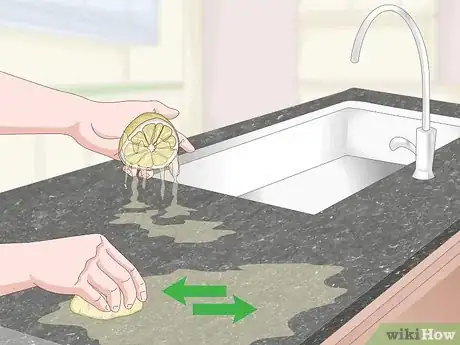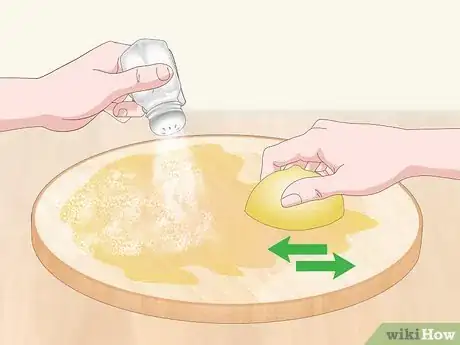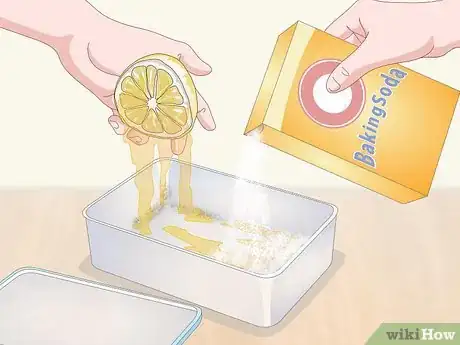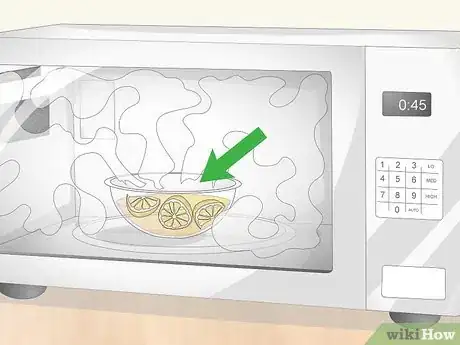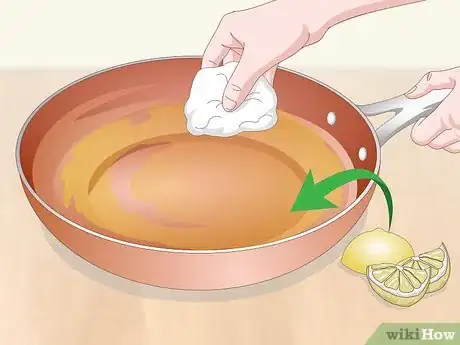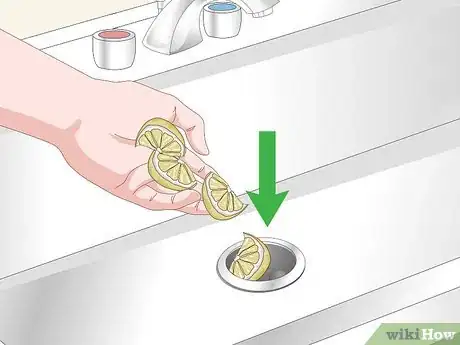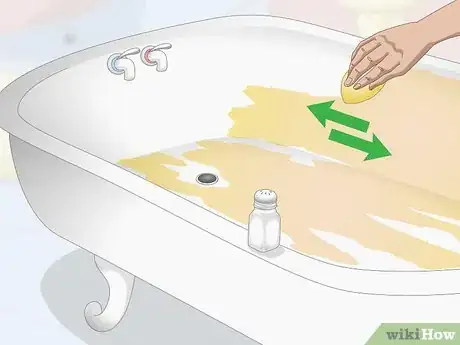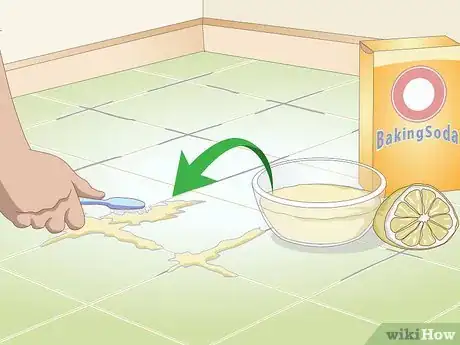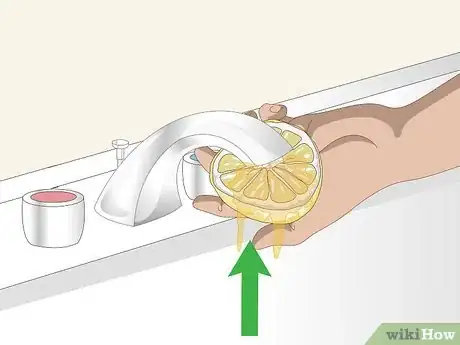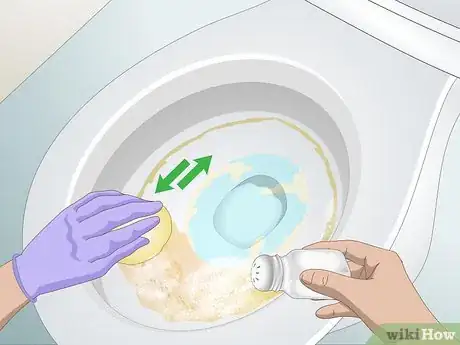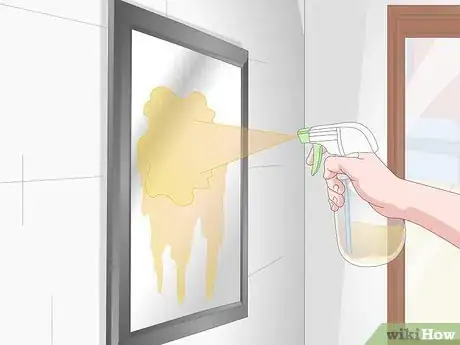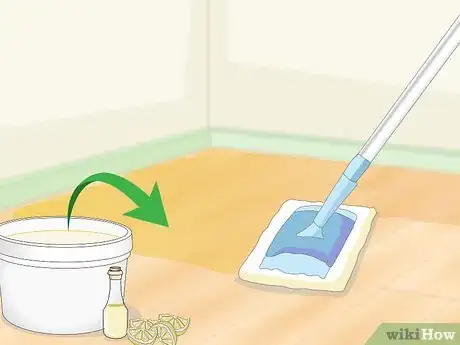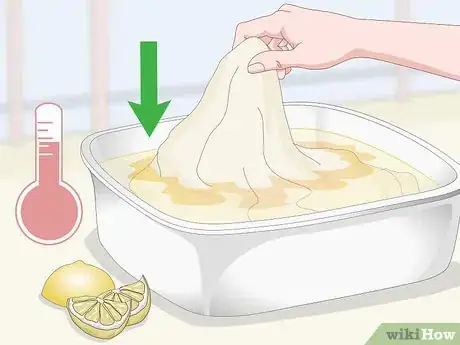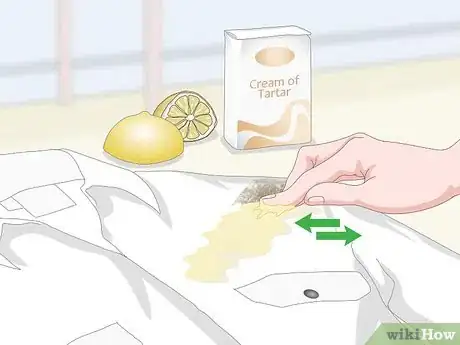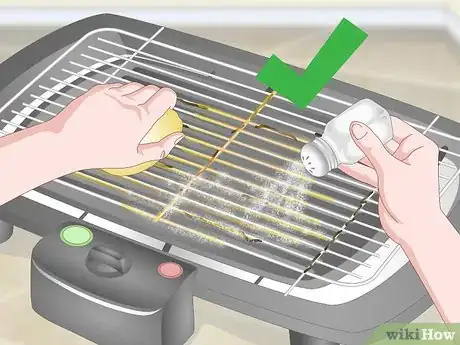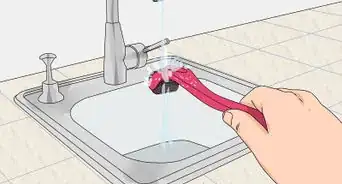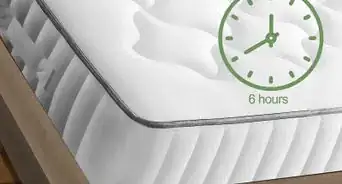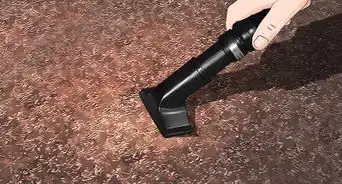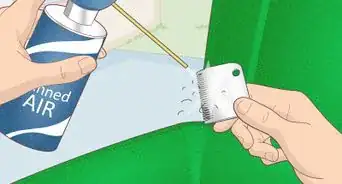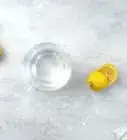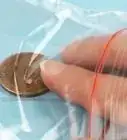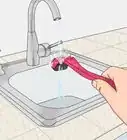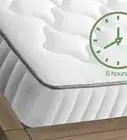This article was co-authored by Michelle Driscoll, MPH. Michelle Driscoll is the Owner of Mulberry Maids, which is based in Fort Collins, Colorado. With five years of experience, her business specializes in cleaning homes and small offices. She holds a Masters in Public Health from the Colorado School of Public Health. Additionally, Mulberry Maids has an A+ rating from the Better Business Bureau.
There are 18 references cited in this article, which can be found at the bottom of the page.
This article has been viewed 41,277 times.
There’s nothing more refreshing and clean-smelling than a freshly-squeezed lemon. Instead of relying on the citrus fragrances found in harsh chemical cleaning products, you’ll be delighted to find that fresh lemons can be used to clean the kitchen, bathroom, and other surfaces around the house. Whether in combination with salt or baking soda, or simply mixed with hot water, a lemon’s acidic juices will eliminate a variety of stains and leave your home sparkling. Pick up an extra lemon at the grocery store and it might just become your go-to cleaning product.
Steps
Cleaning Kitchen Surfaces with Lemon
-
1Remove food stains from laminate kitchen countertops using a lemon. First, wipe away all crumbs and debris from the countertops using a paper towel. Cut a lemon in half crosswise. Then squeeze fresh lemon juice directly from one half of the lemon onto the laminate surface. Rub in the juices using either the remaining lemon half (with the cut-side down) or a cleaning cloth. Once the stains are gone, wipe down the whole area with a damp washcloth.[1]
- Leave the lemon juice to soak on stubborn food stains for 5 to 10 minutes if necessary.
- For a deep-clean, remove all items from the countertop before cleaning. This way, you can reach all the nooks and crannies.
- Avoid using this method to clean porous stone countertops.
-
2Scrub a wooden cutting board with salt and a lemon half. Sprinkle coarse salt over the surface of a wooden cutting board or chopping block. Then cut a lemon in half and place the cut-side down onto the board. Scrub over the salt and any food stains, using the lemon like a sponge. Leave this lemon-salt solution to soak in for 5 minutes or so, then scrub it with a bristle brush. Finally, rinse off the board under hot water, scrubbing it with the brush to remove any residue.[2]
- Squeeze out some of the lemon juice as you scrub, and add more salt as it starts to dissolve. The acidity of the juice and the abrasive texture of the salt will work together to remove tough stains.
- This approach can also work on plastic cutting boards. However, the lemon juice and baking soda process recommended for use on plastic food containers may produce better results.
Advertisement -
3Soak food-stained plastic containers with lemon juice and baking soda. Squeeze the juice of 1 lemon directly into a stained plastic food container or lid. Sprinkle 1-2 tbsp (14-28 g) of baking soda onto the juice and scrub the resulting paste onto all stained sides of the container. Let it sit for a few hours, or overnight, before cleaning the container with hot water and dish soap.[3]
- This method works especially well on tomato-based residue and spice stains.
-
4Use steaming-hot lemon water to loosen food residue from a microwave. Pour 1⁄2 c (120 mL) of water into a microwavable bowl. Add the juice of 1 lemon into the water and then drop the remaining lemon pieces into the bowl. Put the bowl in the microwave and heat it on the high setting for 3 minutes to bring the water to a boil. Keep the microwave closed and leave the steamy lemon-water inside for another 5 minutes.[4]
- Once the food residue has loosened up, remove the bowl and wipe down all of the microwave’s inside surfaces, including the door and turntable, with a cleaning cloth or sponge.
- To dislodge any stuck-on pieces, dip a corner of the cleaning cloth or sponge into the lemon-water and use the damp corner to scrub away the food residue.
- Be careful when removing the bowl and the turntable as they will be hot! Use oven mitts, a potholder, or a towel to protect your hands.
- You can use a similar technique to clean your oven. Fill a baking dish with water and lemon juice, then leave it in the oven on 250 °F (121 °C) for 30 minutes so that the steam can loosen up grimy buildup. Wipe the interior of the oven with a damp sponge after it cools.[5]
-
5Polish tarnished copper pots using a lemon paste. Squeeze the juice of a fresh lemon into a small bowl. Sprinkle either coarse salt or baking soda into the bowl until a paste forms. Use a cleaning cloth to buff the paste onto the tarnished copper surface. Once the tarnished areas are clean, rinse off the copper with warm water to remove all the lemon paste. Lastly, dry the copper thoroughly with a microfiber cloth or paper towel.[6]
- This works well for copper pots as well as decorative copper objects. It can also clean stainless steel pots and pans. However, you should refrain from using lemon to polish other types of fine metal.
- Alternatively, you may sprinkle the salt or baking soda directly onto the sliced lemon. Scrub the lemon over the copper to remove the tarnish, adding more salt or baking soda to the lemon as it dissolves.
-
6Freshen up a garbage disposal with lemon chunks. Slice 1 or 2 lemons into eighths. Squeeze some lemon juice into the garbage disposal and let it sit for a few minutes. Then run a stream of cold water down the drain, turn on the garbage disposal, and drop in 1 lemon piece at a time. The coarse rinds will clean off the blades and the acidic juices will break down food residue while leaving a pleasant, clean smell.[7]
- You can toss in coarse salt and ice cubes with the lemon pieces as well. Alternate adding in the lemon, salt, and ice cubes continuously as you run the garbage disposal. Salt will work with the lemon juices to eliminate food residue, while ice will help clean off the blades.
- You can also try freezing small lemon chunks directly into some ice cubes in an ice tray. Add the lemon ice cubes to your garbage disposal along with some coarse salt.
- This is a great way to use up and dispose of leftover lemons from cooking.
Using Lemon to Clean Bathroom Surfaces
-
1Scrub bathtubs with salted lemon halves to remove soap scum. Both porcelain and acrylic bathtubs can be cleaned with fresh lemons. Slice a lemon in half and sprinkle coarse salt onto the cut side. Scrub the surfaces of the tub with the salted lemon.[8] Let the juice sit on the tub for 5 minutes before rinsing out the tub with hot water.
- Try scrubbing over the cleaning solution with a bristle brush to remove stubborn soap scum and hard water deposits.
-
2Bleach dirty tile grout with lemon juice and baking soda. Mix up a paste with 1 part lemon juice and 2 parts baking soda. Use an old toothbrush to scrub the paste onto moldy, stained tile grout lines. Be careful not to get the mixture on the actual tile. Let the paste sit on the tile grout for 10 minutes or so and then wipe it away with a damp cloth. Finally, rinse off the tile and grout with hot water.[9]
- Porous tile and stone will be damaged by exposure to acid, so avoid directly cleaning them with lemon juice. Keep a paper towel handy to quickly wipe any lemon paste off of the tile as you go.
- If you are using this method to clean all of the grout within your floors or shower, you may need to juice upwards of 6 or 7 lemons to create enough bleaching paste. For small patches, the juice of 1 lemon will be sufficient.
-
3Remove limescale buildup from taps with a lemon half. Cut a lemon in half crosswise. Press it directly onto the end of the tap so that the lemon flesh is “hugging” the tap and totally covering the calcified area. Place a plastic baggie over the lemon and tap, pulling it upwards to hold the lemon in place. Pull the open end of the bag closed around the tap and secure it in place with a rubber band. Leave the lemon in place overnight.[10]
- The following day, remove the lemon and wipe away the loosened limescale buildup with a cleaning cloth. Finally, rinse the tap off with hot water.
- This can be done on shower heads, bathtub faucets, and bathroom or kitchen faucets.
-
4Eliminate hard water rings from a toilet bowl with a salted lemon. Hard water can leave a stubborn ring around the water line of a toilet bowl. To remove these stains, slice a lemon in half crosswise and sprinkle coarse salt onto the cut side. Scrub over the hard water stain with the salted lemon and watch as the acid and abrasion erase the stain. Finally, use a toilet brush or damp sponge to wash away the lemon pulp.[11]
- Shutting off the water to the toilet before you start cleaning can be useful, especially if the stain is sitting at or just below the waterline.
Washing with Lemon Around the House
-
1Spray glass and mirrors with a lemon-water solution. Mix 1⁄2 US gal (1.9 L) of warm water with the juice of 1 medium-sized lemon, which is about 4 US tbsp (59 mL).[12] Pour this solution into a clean spray bottle. Seal it up and shake it to mix the liquids. Spritz the lemon-water solution onto a dirty glass surface. Wipe away the grime using a microfiber cleaning cloth or paper towel.[13]
- This solution works well for a variety of glass surfaces, including window panes, shower doors, glass mirrors, and even vases and stemware.
- Multiply this recipe and soak glassware in a bowl filled with the solution.[14]
-
2Mop and polish hardwood floors with hot water, lemon, and olive oil. First sweep or vacuum the floors to remove crumbs, dust, and other debris. In a bucket, mix a solution of 1 US gal (3.8 L) of hot water, 3⁄4 c (180 mL) of olive oil, and 1⁄2 c (120 mL) of lemon juice. Submerge a mop into this solution and wring it out until it’s just damp. Then mop the floor with this solution and let the hardwood dry completely.[15]
- The water and lemon juice will clean the floors, while the olive oil will condition the wood and leave your floors gleaming.
- For engineered hardwood floors, consult the manufacturer’s maintenance directions and complete a spot-test before using this method. Avoid cleaning porous tile flooring in this manner, as it may get damaged.
-
3Bleach white linens and garments with hot water and lemon juice. Fill a sink or basin with 1 US gal (3.8 L) of hot water and add 1⁄2 c (120 mL) of fresh lemon juice. (This will require about 2 lemons.) Soak the linens or clothing items in the lemon-water. Depending on how discolored the items are, you can leave them to soak for just 1 hour or overnight. After they’ve soaked in the lemon bleach, launder the garments as usual.[16]
- You can slice 2 whole lemons and add them to the water instead of extracting the juice.
- You may also pour the lemon-water into the laundry machine to continue the bleaching process.
- Avoid using this method for cleaning silk. It works best on cotton and polyester.
-
4Scrub rust stains out of clothing using lemon juice and cream of tartar. Squeeze approximately 1 US tbsp (15 mL) of fresh lemon juice directly onto the rust stain. (A lemon half should yield more than enough juice.) Then, sprinkle about 1 US tbsp (15 mL) of cream of tartar over the stain and scrub it in with your fingers. Let the stain-removing paste soak into the garment for 15 minutes and scrub the stain again until it disappears. Finally, rinse off the paste and launder the item as usual.[17]
- Reduce or increase the amount of lemon juice and cream of tartar depending on the size of the stain.
- You may need to repeat the process 2 or more times for stubborn stains.
- This method is suitable for cotton and polyester, but should not be used on silk.
-
5Use a salted lemon half to clean grill and barbecue grates. Prepare by slicing a lemon in half crosswise and dipping the cut end in coarse salt. Then turn the grill to a high heat setting and allow the grates to warm up. Once they’re hot, turn the heat off (or to a low setting) and put on heat-protective gloves. Take the lemon and roughly scrub the salted side over the grates. The acid and abrasion will remove baked-on food residue.[18]
Community Q&A
-
QuestionHow do I use lemon to heal the cracks on my dry feet?
 Community AnswerMix glycerin, lemon, and rose water, and apply this every night. You will see results in no time.
Community AnswerMix glycerin, lemon, and rose water, and apply this every night. You will see results in no time. -
QuestionHow do I remove bleach stains from aluminum?
 Community AnswerApply a solution of a washing up liquid and water to the stain, and blot more of the bleach away. You can alternatively try diluted white vinegar, although be aware that the smell can be relatively strong in combination with the bleach. Rinse the area with clean, cold water.
Community AnswerApply a solution of a washing up liquid and water to the stain, and blot more of the bleach away. You can alternatively try diluted white vinegar, although be aware that the smell can be relatively strong in combination with the bleach. Rinse the area with clean, cold water.
Warnings
- Never mix lemon juice and bleach, since doing so can produce toxic chlorine gas.[21]⧼thumbs_response⧽
- While lemon juice is wonderful at removing food stains, if the surface you’re cleaning (such as a food storage container, a cutting board, or a countertop) has come into contact with raw meat, you should clean it with a more powerful disinfectant before its next use.[22]⧼thumbs_response⧽
- Lemon juice will go off after a few weeks. Use up your homemade cleaning solutions quickly and prepare fresh batches the next time you need them.[23]⧼thumbs_response⧽
References
- ↑ https://earth911.com/living-well-being/health/cleaning-vinegar-baking-soda-lemon/
- ↑ https://www.thekitchn.com/how-to-clean-wooden-cutting-boards-with-lemon-and-salt-cleaning-lessons-from-the-kitchn-195151
- ↑ https://earth911.com/living-well-being/health/cleaning-vinegar-baking-soda-lemon/
- ↑ https://www.thekitchn.com/how-to-clean-your-microwave-with-just-a-lemon-cleaning-lessons-from-the-kitchn-200294
- ↑ https://www.tasteofhome.com/article/20-fresh-ways-to-clean-with-lemon/
- ↑ https://www.mnn.com/health/healthy-spaces/stories/how-to-clean-copper-naturally
- ↑ https://www.apartmenttherapy.com/how-to-clean-your-kitchen-sink-136771
- ↑ https://www.apartmenttherapy.com/how-to-clean-a-bathtub-naturally-with-grapefruit-salt-117590
- ↑ https://www.bhg.com/homekeeping/house-cleaning/tips/clean-with-lemons-281474979479538/
- ↑ https://www.theguardian.com/lifeandstyle/2009/aug/23/how-to-remove-limescale
- ↑ https://youtu.be/KdoVvNxvQFo?t=48
- ↑ https://www.cookinglight.com/cooking-101/how-much-juice-in-one-lemon
- ↑ https://earth911.com/living-well-being/health/cleaning-vinegar-baking-soda-lemon/
- ↑ https://www.cleanipedia.com/gb/kitchen-cleaning/clean-wine-glasses.html
- ↑ https://www.organicauthority.com/live-grow/natural-cleaning-for-clean-floors-that-you-can-make-easy
- ↑ https://www.diynetwork.com/how-to/maintenance-and-repair/cleaning/cleaning-with-lemon-juice
- ↑ https://www.diynetwork.com/how-to/maintenance-and-repair/cleaning/cleaning-with-lemon-juice
- ↑ https://www.dailytelegraph.com.au/newslocal/barbecue-cleaning-can-be-a-chore-in-summer-but-some-simple-household-items-can-make-it-easy/news-story/f76de688e0675e14a191165101ae19ab
- ↑ https://www.apartmenttherapy.com/everything-you-need-to-know-about-cleaning-with-lemons-250575
- ↑ https://justonetree.org/61-things/
- ↑ https://www.apartmenttherapy.com/everything-you-need-to-know-about-cleaning-with-lemons-250575
- ↑ https://earth911.com/living-well-being/health/cleaning-vinegar-baking-soda-lemon/
- ↑ https://cleanmyspace.com/10-things-you-can-clean-with-lemon/
